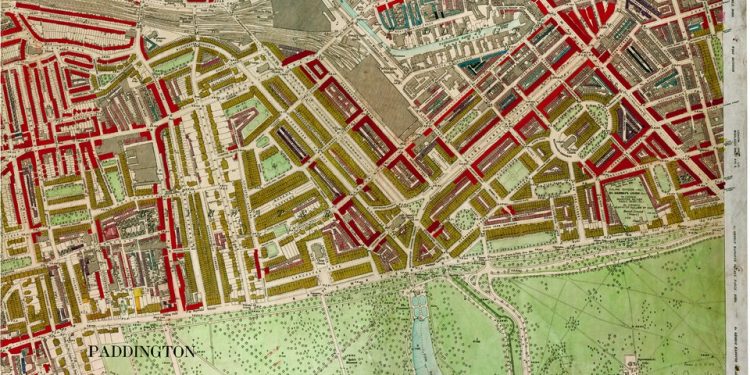Flicking by means of the brand new version of Charles Booth’s London Poverty Maps, up to date Londoners could be struck with a sense of déjà vu.
The e book is a reprint of a gargantuan examine carried out between 1889 and 1903 by Victorian social reformer Charles Booth, whose extremely detailed maps (totally viewable on-line here) catalog precisely how wealthy or poor London was—avenue by avenue, and typically even home by home. Every row of homes within the landmark examine is categorized in shade grades starting from “rich” all the way in which right down to “lowest class: vicious, semi-criminal.” The maps supply an unbelievable doc of late Victorian London.
On the identical time, this new version, accompanied by compelling if bleak interval images, reveals a metropolis that possesses echoes of London in the present day. It depicts, in spite of everything, a densely-packed metropolis with a cosmopolitan inhabitants the place immensely rich individuals lived simply across the nook from neighbors who have been struggling to make ends meet.
Take the map above of Westminster, for instance. Most distinguished on the map is Buckingham Palace, already in possession of London’s largest non-public backyard and coloured in orange to suggest upper-class residents. Flanked by parkland and grand homes, you would possibly count on the palace to solely have plutocrats for neighbors. Only a few minutes down the grand avenue of Birdcage Stroll, nonetheless, you discover a semi-hidden avenue coloured in black, to suggest residents so poor they could frequently resort to crime to remain alive. This slim lane is Old Queen Street, a backstreet of as soon as grand 17th-century homes (lots of which nonetheless stand) that had clearly fallen on exhausting occasions.
In east London, issues have been even starker. Have a look at this map of the internal East Finish, left clean inside the space of the Metropolis of London the place knowledge was apparently unavailable. The black rows depicted top-center within the map present Dorset Road, a lane then generally known as the “worst street in London,” a spot that, in response to one eye witness, “teemed with nasty characters—determined, depraved, lecherous, razor-slashing hoodlums,” and acted as a type of consciously tolerated holding pen for London’s underbelly.
This underbelly was massive. Sales space’s personal analysis revealed that throughout the interval of his examine (and in contradiction of the marginally decrease numbers talked about on the important thing sheet above) roughly 35 % of Londoners have been residing in abject poverty. This meant they weren’t simply poor in relation to their extra affluent neighbors, however have been struggling day by day to cobble collectively the meals, shelter, and clothes they wanted to remain alive. And for some, issues have been getting worse.
We have a tendency to think about the 19th century as a dirty however sure-footed march towards prosperity. London in Sales space’s day, nonetheless, was hard-bitten by the so-called Long Depression, its inhabitants swollen by escapees from Eire’s major famine of 1879. Reformist efforts have been beginning to kick in—Sales space’s maps already present East London’s half-built Boundary Estate, a ground-breaking slum clearance and inexpensive housing scheme—however these wouldn’t have reached the poorest.
Newly-built “model dwellings” for the working poor, constructed by American-born philanthropist George Peabody, amongst others, typically barred tenants who had no fastened employment or who did piecework at dwelling, that means that determined staff just like the exhausted household of matchbox makers captured within the {photograph} beneath wouldn’t have been eligible to lease one, even when their means had stretched to the modest lease. If higher circumstances for the poor have been coming, they have been nonetheless a great distance away.
Return to those self same websites of poverty in the present day, nonetheless, and the transformation in wealth is dramatic, powered by higher residing requirements in addition to a drastic rearrangement of the place totally different social courses reside in London in the present day. Previous Queen’s Road, the poverty-stricken lane close to Buckingham Palace, is now ludicrously costly: A home on the road is currently on sale for slightly below $23 million. In the meantime, over in East London, Dorset Road’s warren has been largely demolished and is now dwelling to finance firms and a department of Chanel, relatively than brothels and flop homes.
However nonetheless one thing lingers. Stroll by means of the surviving alleyways close by and there’s some miasma of the previous rising by means of the paving. Reworked right into a metropolis throughout Sales space’s time, London might attempt to consistently reinvent itself, to pile its floor ever larger with metal and concrete annually, however the metropolis has by no means actually misplaced that period’s stamp, each in its vibrancy and inequality. Beneath this new flesh, nonetheless, the town’s dank Victorian bones all the time in some way present by means of.
Charles Booth’s London Poverty Maps, by Mary S. Morgan, Iain Sinclair and the London College of Economics, shall be revealed within the U.S. by Thames and Hudson on November 12.
Author: ” — www.citylab.com “


